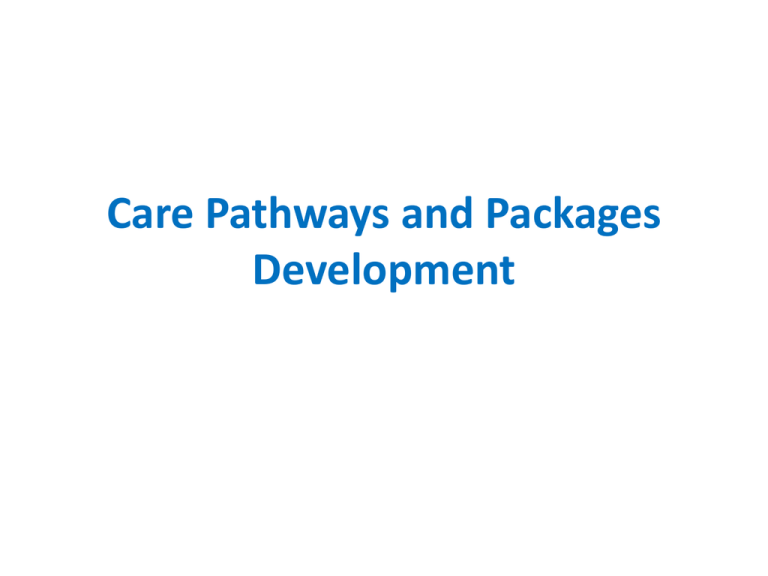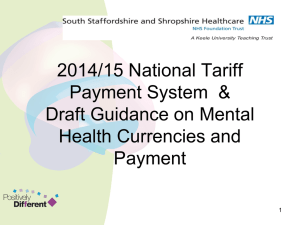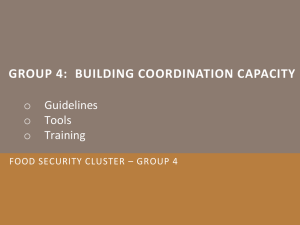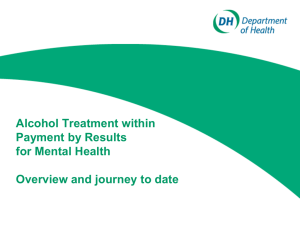problems - The Care Forum
advertisement

Care Pathways and Packages Development Data items within the Mental Health Clustering Tool HoNOS 1 OVERACTIVE, AGGRESSIVE, DISRUPTIVE OR AGITATED BEHAVIOUR* 2 NON ACCIDENTAL SELF-INJURY 3 PROBLEM DRINKING OR DRUG-TAKING 4 COGNITIVE PROBLEMS 5 PHYSICAL ILLNESS OR DISABILITY PROBLEMS 6 PROBLEMS ASSOCIATED WITH HALLUCINATIONS AND DELUSIONS 7 PROBLEMS WITH DEPRESSED MOOD 8 OTHER MENTAL HEALTH AND BEHAVIOURAL DISORDERS 9 PROBLEMS WITH RELATIONSHIPS 10 ACTIVITIES OF DAILY LIVING 11 LIVING CONDITIONS 12 PROBLEMS WITH OCCUPATION AND ACTIVITIES Summary Assessment of Characteristics (SAC) 13 STRONG UNREASONABLE BELIEFS A AGITATED BEHAVIOUR / EXPANSIVE MOOD (H) B REPEAT SELF HARM (H) C SAFEGUARDING CHILDREN & VULNERABLE ADULTS (H) D ENGAGEMENT (H) E VULNERABILITY (H) 2 Mental Health PbR Development Mental Health Care Clusters Working-aged Adults and Older People with Mental Health Problems A B C Non-Psychotic Psychosis Organic a b a b c d a Mild/ Very Severe and complex First Episode Ongoing or recurrent Psychotic crisis Very Severe engagement Cognitive impairment Moderate/ Severe 01 02 03 04 05 06 07 08 10 11 12 13 14 15 16 17 18 19 20 21 There are two additional codes if it is not possible to allocate to a Cluster or Super Class: Z - Unable to assign patient to Mental Health Care Cluster Super Class 0 (Variance) 3 Cluster payment periods • • • • • • • • • • • 1 Common mental health problems (low severity)-12 weeks 2 Common mental health problems-15 weeks 3 Non-psychotic (moderate severity)-6 months 4 Non-psychotic (severe)-6 months 5 Non-psychotic (very severe)-6 months 6 Non-psychotic disorders of overvalued Ideas-6 months 7 Enduring non-psychotic disorders (high disability)-Annual 8 Non-psychotic chaotic and challenging disorders-Annual 9 Blank cluster-Not applicable 10 First episode in psychosis-Annual 11 Ongoing recurrent psychosis (low symptoms)-Annual Payment Periods Cont’d • 12 Ongoing or recurrent psychosis (high disability)-Annual • 13 Ongoing or recurrent psychosis (high symptom and disability)-Annual • 14 Psychotic crisis-4 weeks • 15 Severe psychotic depression-4 weeks • 16 Dual diagnosis (substance abuse and mental illness)-6 months • 17 Psychosis and affective disorder difficult to engage-6 months • 18 Cognitive impairment (low need)-6 months • 19 Cognitive impairment or dementia (moderate need)-6 months • 20 Cognitive impairment or dementia (high need-6 months • 21 Cognitive impairment or dementia (high physical or engagement)-6 months Relationship between mandated and proposed forensic, LD & alcohol misuse clusters Main elements of the CPP Model Individual service user needs Anxiety / Accommodation / Hallucinations / Living conditions etc. Mental Health Clustering Tool Standardised summary of individual needs Cluster Global description of combination & severity of individual needs Care Packages Negotiated care plan Quality and Outcome Metrics Triangulated measurement of process and effect Local Tariff Derived from joint understanding of accurate costs Person One Big Conversation Outputs Outcomes Mental Health PbR CPA Non CPA Support Plan Social Care FACs Financial Assessment Personal Budget Physical Health Long terms condition Personal Health Budget Care Coordinator Covering elements of Mental Health Care Programme Social Care Activities/support Health Activities/Support Next Steps • DOH acknowledge project slippage • New Cluster booklet • New 2013-14 Guidance for Commissioners and Providers • Commissioners considering Care Planning CQUIN • Major emphasis on accurate data collection MH PbR Project summary Working Age Adults / Older People Implementation Finance / Costing Algorithm / Transitions Quality and Outcomes Extending the Scope Forensic Learning Disabilities Psychological Medicine IAPT CAMHS Alcohol IC supporting requirements for all work streams Finance Work plan Priorities for Development for 2014/15 Objectives Develop stable and transactionally simple payment mechanism for 2014/15, building on 2013/14 guidance, which maintains overall financial stability but increases relationship between payment and caseload, and builds in incentives and penalties for delivering on quality standards and outcomes Deliverables •Develop business rules which increase link between payment and active caseload at a cluster level •Develop incentives and penalties framework for the contract to support: •Improvement in outcomes for patients and defined through the quality and outcomes work stream •Delivery against standards for care delivery (review periods, transitions, etc) •Data quality •Develop pricing and costing guidance on initial assessment-single assessment price or cluster dependent •Develop cluster pricing and costing model for inpatients to include review of period durations for in-patient stay, in-patient usage by bed type by cluster, develop data set of interventions in an in-patient setting to understand variation by cluster. •Review options for standardising cluster period considering current national standards, lower as well as outer limits, average, mean and bets practice, in conjunction with quality and outcomes work stream •Develop standardised data set to support PBR, linked to MHMDS deliverables and work plan, identifying nationally available solutions and local requirements through 2014/15 •Ensure business rules support required developments in Choice agenda for 2014/15 •Ensure alignment and consistency in development of payment mechanism across all areas of mental health and LD •Develop understanding of variation in price associated with variation in provider landscape Timescales Outline business rules framework to be developed by May 2013 and agreed by Monitor and NHS England Draft Guidance to be produced by Sep 2013, Ongoing benchmarking and shared learning through the year. Approach Outline business rules framework to be developed by May 2013 Publication of indicative prices May 2013 Quarterly Review of lessons learned Integration with quality and outcomes work stream to develop incentives and penalties framework Integration with all work streams and IC to develop standardised data set Development of national template for data collection of prices, activity and quality metrics in October 2013 Selected deep dives on a cluster specific basis to understand variation in provider landscape IC Requirements NOT FUNDED: Analysis to support inpatients work, cluster periods and transitions, work on business rules, work on variation, work on benchmarking, work on other national data collections; reporting warehouse at Exeter for fast reports to commissioners on PbR activity. FUNDED: MHMDS maintenance to take changes through approval process. Risks Future developments Q&O Objectives To develop a fit for purpose Quality and Outcomes Framework for use in Mental Health Payment by Results (PbR). Deliverables To test whether SWEMWBS proves sensitive to change over time and whether it can be used as the generic PROM for the MH PBR Framework. To identify and recommend a range of patient experience measures which will inform and support mental health PbR. To establish how the HoNOS measure can be practically implemented within the PbR framework. To put in place a set of quality indicators that are ready for use as part of the MH PbR Framework Scope Timescales Signal key proposals June, publish September WEMWBS pilot - at least 15 months. Friends and Family tested through 13/14. Other experience questions developed in 13/14. HoNOS – final testing in early 13/14. Baseline data being collected nationally from April 2013. Approach IC Requirements NOT FUNDED: taking any of the 12/13 work and producing routinely; further investigation work for 13/14; work on indicator development and production. Inexpensive developments – CROMS analysis, clustering quality indicators, urban/rural splits, DUP. FUNDED: limited reporting in monthly MHMDS file at organisation level, selected numerator and denominator measures. Risks Inconsistent approaches to gathering data nationally across the project. Future Developments AlgorithmTransitions Objectives Ensure that the algorithm is fit for purpose as a decision support tool at the initial cluster assessment. Review the transitions and cluster tool rules to ensure that they reflect current practice. Assess the potential for an algorithm to be used at a review assessment. Deliverables An agreed methodology for collecting feedback from providers on their use of the algorithm in practice, and for identifying aspects of the algorithm requiring further modification A programme of further development of the algorithms as required A process for signing off the algorithm for application for an ISN Recommendations for any changes to transitions and cluster rules Improved cluster booklet guidance Scope Timescales Develop questionnaire for methodology for collecting qualitative algorithm feedback April/May 2013 Develop approach for assessing use of transitions and rules in practice April to August 2013 Write out to providers June 2013 to get numbers of user organisations and agreement to provide qualitative feedback on algorithm and use of transitions and cluster tool rules in practice September 2013 collect feedback. Review feedback October 2013 Recommendations for changes to transition and cluster rules November 2013 Develop methodology for developing quantitative analysis on algorithm October/November 2013 Write to providers for quantitative feedback December 2013. Collect feedback January 2014. Amend algorithm February 2014. Publish revised algorithm March 2014 Approach IC Requirements Risks Future Developments NO WORK FUNDED. Key milestones • • • • Readiness review completed PbR CQUIN agreed Joint action plan developed for 2013-14 MOU signed and cluster monitoring with commissioners started • Stronger links between PbR and operations • Pre cluster tariff (P) developed for PCL • Local tariff to be agreed by year end 2013-14 CQUIN • PbR PREM . Tied into national patient surveyTop 4-6 questions • PROM- Short version of the WEMHWS • Family and Friends Test • All of the above on one simple questionnaire • Still keeping a watching brief on clustering Training Programme Quantitative Qualitative RiO/CAST Assessment Formulation HoNOS/Cluster (CAST) Cluster transitions Knowledge Centre Problem List Care Plan Problems (categories) Care Plan Interventions (categories) RiO Text fields Assessment Formulation writing HoNOS/Cluster Cluster transitions Knowledge Centre Problem List Care Plan Problems (text) Care Plan Interventions (text) Clinical Dashboard/Reporting HoNOS/Cluster completion Cluster accuracy (Red Rules) Care Plan completion HoNOS/Care Plan problems (Red R) Problem/Intervention guidelines Caseload profile Outcomes (HoNOS) Resources Supervision HoNOS/Cluster completion Cluster accuracy Care Plan completion HoNOS/Care Plan problems Problem/Intervention guidelines Caseload profile Outcomes (HoNOS) Resources Forensic Objectives To develop a currency model for testing in 14/15 that meets the agreed criteria. Deliverables Reports on the qualitative and quantitative analysis of the current data collection – July 13 Proposals for currency model testing in 14/15 – September 13 Proposals for the quality and outcomes to be used within the currency model – December 13 Proposals for the costing methodology to support 14/15 testing – December 13 Scope High, medium and low secure mental health and learning disability services Timescales Report and recommendations for future developments September 13 Model testing during 14/15 Approach Data collection required through contracts Secure PRG sub group leading the project work IC Requirements No analysis work funded. Risks Model not workable across all levels of security Data quality inadequate for purpose Future Developments Learning Disabilities Objectives •To consider potential expansion of the current MH clusters by creating a seamless continuation for patients requiring input from NHS funded specialist adult Learning Disabilities health services . •To undertake a pilot project to develop a new Learning Disabilities clustering process. Deliverables •Integrated Mental Health and Learning Disability Clustering Tool. •Additional guidance specific to Learning Disability. •New set of Learning Disability Clusters. •Final report outlining proposed clustering tool, new clusters and next steps. Scope Inpatient and community specialist adult Learning Disability health services. Timescales Submission and analysis of pilot site data – Oct-Dec 2012 Service User/Family carer consultation events – Oct 2012 Learning Disability cluster development workshops with stakeholders – Jan-Feb 2013 Initial validation of new Learning Disability clusters with pilots sites – Apr-May 2013 New Learning Disability clustering process within report to National PbR group – June 2013 Approach Analysis of clustering data from pilot sites, service user/clinician consultation across the participating pilot sites and validation of a new set of Learning Disability clusters with participating sites. IC Requirements Funded – expanding the scope of MHMDS to include LD (phase 1). Risks Uncertain mandate within NHS Commissioning and DH Learning Disability policy Future Developments To be determined following the above report findings Psychological Medicine Objectives To develop recommendations for an incentivised payment mechanism based on integration that discourages the separation of physical and mental health, that improves patient outcomes, reduces costs, and improves system functioning. Proposals to be developed in 2013/14 followed by further development and testing in subsequent years. Deliverables •T o develop a proposals for system enabling services. • To develop proposals for a payment mechanism for clinical care that incentivises improved outcomes. An initial piece of analysis will be undertaken with the following remit: • Breakdown of the amount of investment in liaison • Summary of how it is commissioned and who commissions the work. • Overview of good practice models of where it is working well. • Summary of outcome measures that are in place. • Cover acute, community and mental health settings. • Considers the next generation, training and expansion. • Would examine whether enabling services could be funded centrally or locally. Scope Hospital and community. Peri-natal and neuro-psychiatry are within scope. Full scope of project will be agreed following delivery of initial analysis. Timescales June/July for delivery of initial report. Approach TBC following initial scoping work. IC Requirements No work funded. Risks TBC IAPT Objectives To develop an outcomes based currency for IAPT services Deliverables A software package to calculate currencies for commissioned services at monthly intervals Data completeness and data quality higher than 90% A method of incorporating MH Cluster in the model, determined by way of an extended pilot Evidence the model is appropriate across a wide range of providers, provided by way of an extended pilot Scope Any IAPT service in England will be eligible to take part in the extended pilot, all the 23 commissioned services that took part in the feasibility pilot will be encouraged to continue. The MDS and the PbR Data set will be submitted centrally and analysed. The currency model will be applied to the model and the results reported Timescales The extended pilot will run for 12 months, 2013/14. Data will be analysed to support a decision about a possible full road test for 2014/15 and further analysed for a decision about 2015/16 in line with the new PbR planning cycle. Approach The approach is an extended pilot, with associated statistical and economic analysis running in parallel with software development IC Requirements The HSCIC will need to continue to make data available via the data depot for each of the extended pilot commissioned services. The HSCIC will also support changes to the MDS and changes to clinical systems. They will need to support the development/integration of the software, it may be case-mix write this software, or commission it. Risks No funding exists for this development, thus it is likely to start late, meaning decisions will be made with less data, thus making those decisions prone to error Future Developments Once the currency has been sufficiently developed a national road test will be used to establish baseline performance of every commissioned services over a full financial year, this will enable the currency to be deployed with local prices in the following financial year CAMHS Objectives To develop national currencies that can be used as the basis for contracting and paying for child and adolescent mental health services in England . To produce a more transparent funding system for child and adolescent mental health services, with clarity as to what care is being provided, how it is paid for and by whom, and what outcomes are being delivered To ensure that funding reforms support child and adolescent mental health services policy objectives Deliverables Allocation tool Clusters Algorithm Associated guidance material Approach to care package development Scope Tiers 2-4 Will exclude non mental health LD services Timescales Pilot of allocation tool underway. Draft clusters - Autumn 2013 Finalised clusters, algorithm and associated guidance September 2014 Approach Identification of assessment factors that are associated with resource use through analysis of existing data sets and collection of prospective data. Collection of outcome IC Requirements CAMHS minimum data set mandated from April 2013 IC notified of changes required for PbR (and CYPIAPT implementation) for 2015/6 Risks Technical difficulties with prospective data collection Data not conclusive Objections from clinicians/commissioners Future Developments Alcohol Objectives Local authorities take over the responsibility to commission alcohol treatment services from April 2013. Local authorities are not mandated to implement Mental Health PbR. Nevertheless, the range of products developed to support alcohol treatment PbR can be used as a programme of systems improvement and on an elective basis, be used as currencies for payment within contracts between local authorities and mental health trusts or voluntary sector agencies delivering alcohol treatment. Deliverables To provide cluster/currencies that identify the range of complexity of patients seeking alcohol treatment. These clusters will: • Be based on - The Mental Health Clustering Tool PLUS - Appropriate alcohol dependency measures • Segment the alcohol treatment seeking population into complexity groups To specify the appropriate packages of care, based on NICE guidance, to address the treatment needs of patients in each cluster To make available the range of Outcome measures found to be effective in the 4 pilot sites To make available the methods used in the 4 pilot sites to determine the cost of delivering appropriate packages of care to patients in each of the clusters Scope Hospital and community specialist alcohol treatment services. Timescales April/May for delivery of clusters/currencies May/June for refined packages of care September for Outcome measures September/October for costing examples Approach Analysis of clustering data, treatment journey data and in consultation with the 4 pilot areas IC Requirements No work funded. Risks Limited available time for analysis Pilot site continued participation in light of their busy schedules Future Developments







